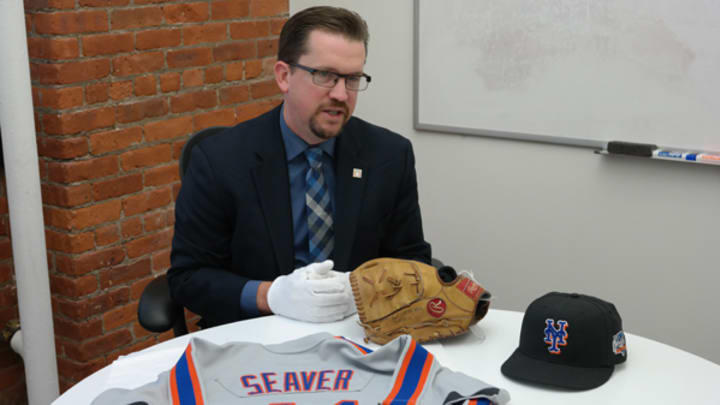Cooperstown Collector Preserves Baseball History

Ever wonder how items from famous baseball games end up in the Hall of Fame? Or who decides which pieces are worthy?
The answers to both questions lie with Brad Horn, Vice President of Communications and Education at the National Baseball Hall of Fame and Museum in Cooperstown, NY.
Before Tuesday’s AL Wild Card game at Yankee Stadium, for instance, Horn read that ESPN commentator Jessica Mendoza would be the first woman to call a postseason game. Before the game, he walked up to Mendoza on the field and asked if she would donate her scorecard from the broadcast for the Hall of Fame’s “Diamond Dreams: Women in Baseball” exhibit. She happily agreed. Now, a signed scorecard from the Astros’ 3-0 victory over the Yankees is headed to Cooperstown.
Collectors and former players donated many of the items in the museum. But the ability to acquire memorabilia on the field or in the clubhouse gives the Hall unique opportunities to preserve historic moments right after they happen.
“Nothing can replace the player-to-the-Hall-of-Fame direct connect,” Horn says.
And that’s where Horn comes in. He makes a point of being present when greatness is possible. He was in St. Louis for Game 6 of the 2011 World Series when the Cardinals’ David Freese hit a bottom-of-the-ninth triple to tie the game and a bottom-of-the-eleventh home run to win it. After the winning dinger, the Cardinals’ equipment manager presented Horn with the remains of Freese’s jersey, which had been torn up in the celebration. Horn also immediately grabbed Freese’s bat, which the Cards’ third baseman was not too superstitious to want to keep for Game 7.
Horn started working at the Hall of Fame in 2002, so he has established a rapport with the league’s equipment managers and players who have a habit of making history.
Derek Jeter is an obvious pick among modern players with memorable careers. Horn says the former Yankees captain donated often to the Hall. But it's another great contact hitter whose frequent contributions stick out in Horn’s mind.
“Ichiro has been amazing,” Horn says. “He’s donated more than two dozen pieces of his career to the Hall of Fame. Quite frankly, no one in history has ever been as generous as Ichiro has been as an active player.”
As the playoffs continue, Horn will be attending games and collecting more artifacts for the Hall’s cache. Cooperstown has about 4,500 pieces on display at any one time, with another 40,000 “three dimensional” items in storage. In all, when you visit the Hall of Fame, you’re only seeing 10-12 percent of their collection.
That, of course, makes Cooperstown worth visiting more than once. You’re sure to see something you haven’t before — either because it wasn’t on display the last time your were there, or because the great moment it signifies hadn’t yet happened.
When it does happen, though, bet on Brad Horn being there.
Photos: MLB.com



